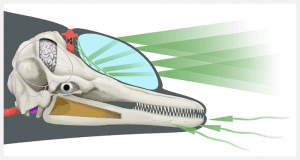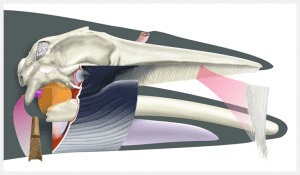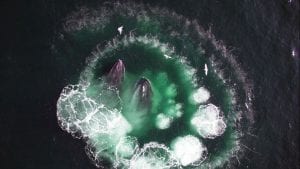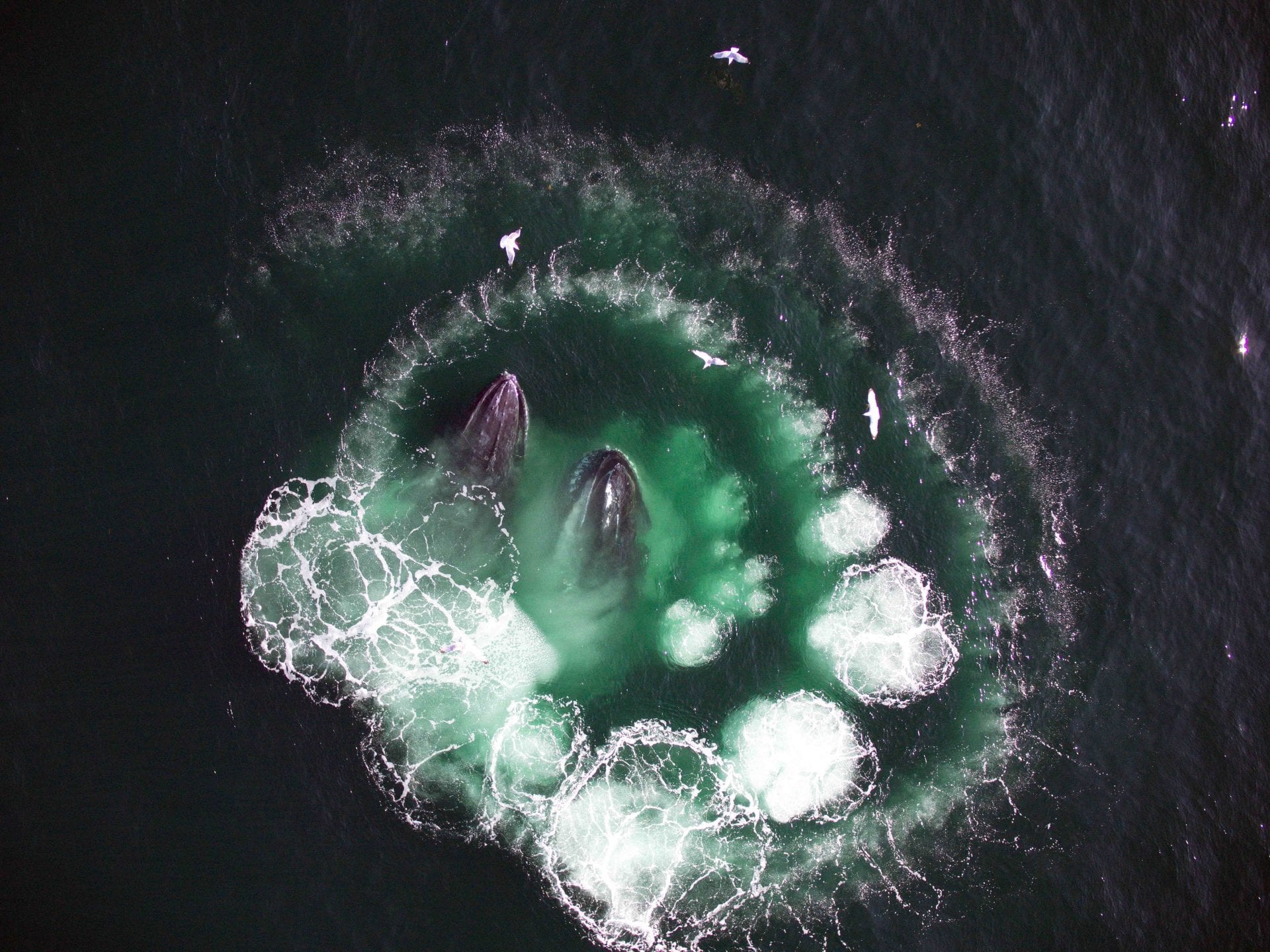Feeding
Tooth vs. Baleen Strategies
Whales, dolphins and porpoises are all predators. But the way they catch their prey depends on what they are eating. They are able to taste their food; they do have taste buds.
Cetaceans with teeth (odontocetes) eat squid, octopus, fish, prawns, crustaceans, and other marine mammals, and all have the ability to find food and to navigate by using sound rather than sight. This is called echolocation. They are able to process the information received when sounds they create in their heads, and send out via an oil-filled organ called a melon, reflect off of objects in the water and return to the animals through their jaws. Their brains translate the sounds into images that inform the odontocetes as to what is in front of them, including prey items. Once they get close enough to their food, they suck in their food and swallow it whole. Some of the animals, such as dolphins, have sharp teeth that can grab prey if it tries to swim away. Much of the ocean is dark, so having the ability to find food where there is little to no light is very important for survival. You could say that they can find their food with their eyes closed.

Credit: Jon Hlidberg and Tyler Steff. Property of NBWM.
An adult sperm whale can eat as much as a ton of squid per day. There are 500 species of squid in the ocean with sizes that range from 0.75 inch (10mm) to more than 30 feet (9.2 meters). The species of prey that the whales, dolphins and porpoises eat depend on where they live.
Cetaceans with baleen (mysticetes) eat small prey items, such as krill, copepods and other zooplankton, or capelin, sand lance, or other small fish, by straining it out of the water. They use plates of baleen, made of keratin just like our hair and fingernails, that hang from their upper jaws to filter these small creatures. These baleen plates are lined up very close together leaving little space for anything except sea water to sneak through. The edge of the baleen that faces in toward the tongue and throat is fringed with hair or bristles that trap the prey. The whale can also use its tongue to push water through the baleen and out of the mouth. They then swallow the mouthful of food without chewing it.
Because cetaceans swallow their food rather than chew it, they have an adaptation that does the job of grinding up the food the way that our back teeth do to start the process of digestion. They have multiple stomachs which help to store the food, grind the food, process the food, and pass it along for further digestion. The whales in our museum would have had three stomachs, or some would say one stomach with three compartments.

Credit: Jon Hlidberg. Property of NBWM.
The amount of food eaten by cetaceans varies by species, by age and by activity. Just like humans, a young growing cetacean has greater nutritional needs than a full grown adult. Immature animals generally eat twice as much as matures. A lactating or pregnant female needs more calories than an adult female who is doing neither. For example, a right whale that is nursing a calf needs to eat twice as much food as a female who is not. Smaller bodies tend to lose heat more quickly than larger bodies. So, smaller cetaceans might eat 4-5% of their body mass each day; larger animals eat slightly less, typically 2-3% per day. In other words, a 200 lb (90 kg) common dolphin could eat 8-10 lbs (3.5-4.5 kg) of squid or fish. A 100,000 lb (45454 kg) right whale would eat 2000-3000 lbs (909-1364 kg) of copepods.
Learned Behaviors
Some species, such as humpbacks, orcas, and bottlenose dolphins have devised hunting schemes that are taught to juveniles and others in their pods. The best known is bubble net feeding used by some populations of humpback and Bryde’s whales. A small pod of whales will form a circle, one or two will blow bubbles into the water trapping a school of baitfish inside this bubble curtain, and then one whale will signal the others to surge through the school of fish with mouths open to trap the fish.

Humpback whales bubble net feeding. Photo Credit: John Durbin.
Dolphins that live near Kiawah and Seabrook Islands in South Carolina have learned how to work together to force fish onto the muddy banks of the inlet and then swim up on the shore to grab the fish. They then have to wiggle themselves back into the water.
Orcas that live in polar seas work in teams to create waves to wash seals off of ice floes or to split up the ice so the seals will fall off.

Pitman whale and seal. Photo Credit: RL Pitman, SWFSC/NOAA.
Sadly, there are times when some individuals will enter a habitat to find food and while they are feeding the water level will change as the tide goes out. This lower water level may change access to the outlet of that habitat and may also change the acoustic surroundings. Animals that try to echolocate in these shallow areas get confused and can’t find the way out. This has led to strandings and deaths.


